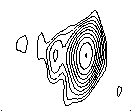
Radio map 8 Kb |
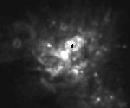
Greyscale image 16 Kb
Full size image 45 Kb |
| NGC 5253: This remarkable
starburst dwarf galaxy, 2.8 Mpc away, is the site of the youngest starburst
known. On the left is the 1.3 cm radio map of an intense radio/infrared
source which we consider to be a super-star-cluster and the very youngest
globular cluster--only about a million years old--that has ever been observed.
On the right is the Halpha image of the galaxy from the Hubble
Space Telescope. The intense source is blacked out in the center. The
starburst in this galaxy may have been started by the accretion of a small
cloud of gas from inter-galactic space. |
Press release of January 2000
Press release of June 2001
|
|
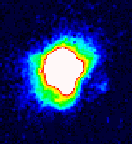
False color image 16 Kb |
| Henize 2-10: This
galaxy looks at first to be a normal small elliptical, but on closer examination
it contains a mature starburst, about 10 million years old, that was probably
started when Henize 2-10 swallowed an even smaller galaxy. The picture,
taken at Tel Aviv University's Wise
Observatory, shows the faintest parts of the Halpha emission (the bright
center is whited out); note the shells and streamers of ionized gas and
the little clump of emission outside the main part of the galaxy on the
right. That clump is a small star cluster that formed at the end of the
tidal tail that remained after the little galaxy was swallowed. |
|
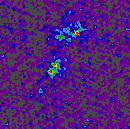
False color image 16 Kb |
| NGC 4214: This Magellanic
Irregular galaxy (see Hubble images) has star formation in clumps all across its center. The
picture shows the 2 cm radio emission, measured at the Very
Large Array; the bright knots are probably super-star clusters. The
star formation in the northern section has a form of an arc around a hole.
There is a very bright UV source in the hole which may have created the
hole, by blowing out the gas, and triggered star formation in the arc by
compressing and heating the gas there. |
|
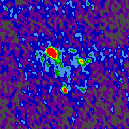
False color image 16 Kb |
| Makarian 8: This
picture shows the 6 cm emission from this galaxy, measured at the Very
Large Array. The clumps of young stars form a rough ring. This may
be the result of two galaxies colliding to make a new one. |
|